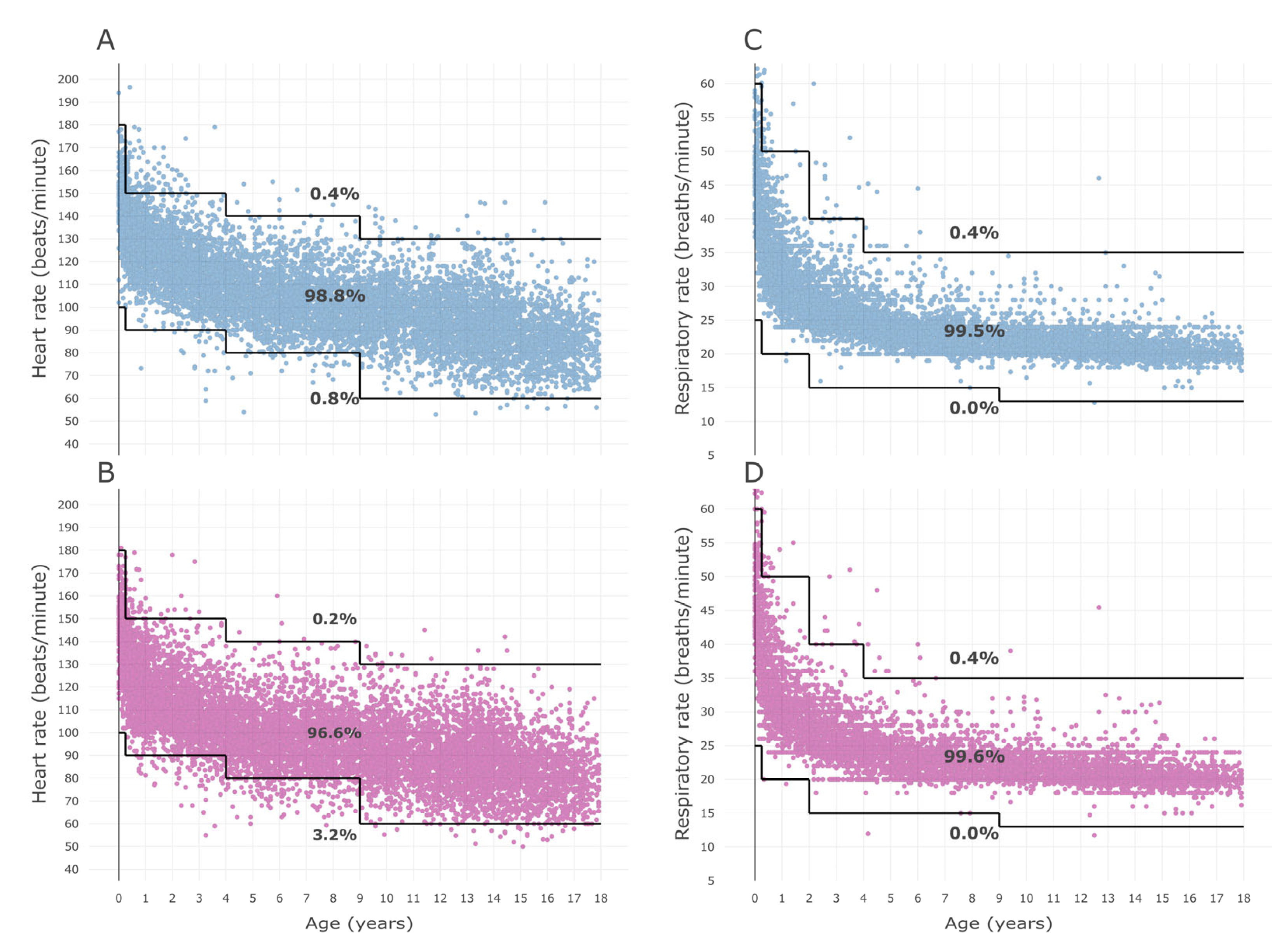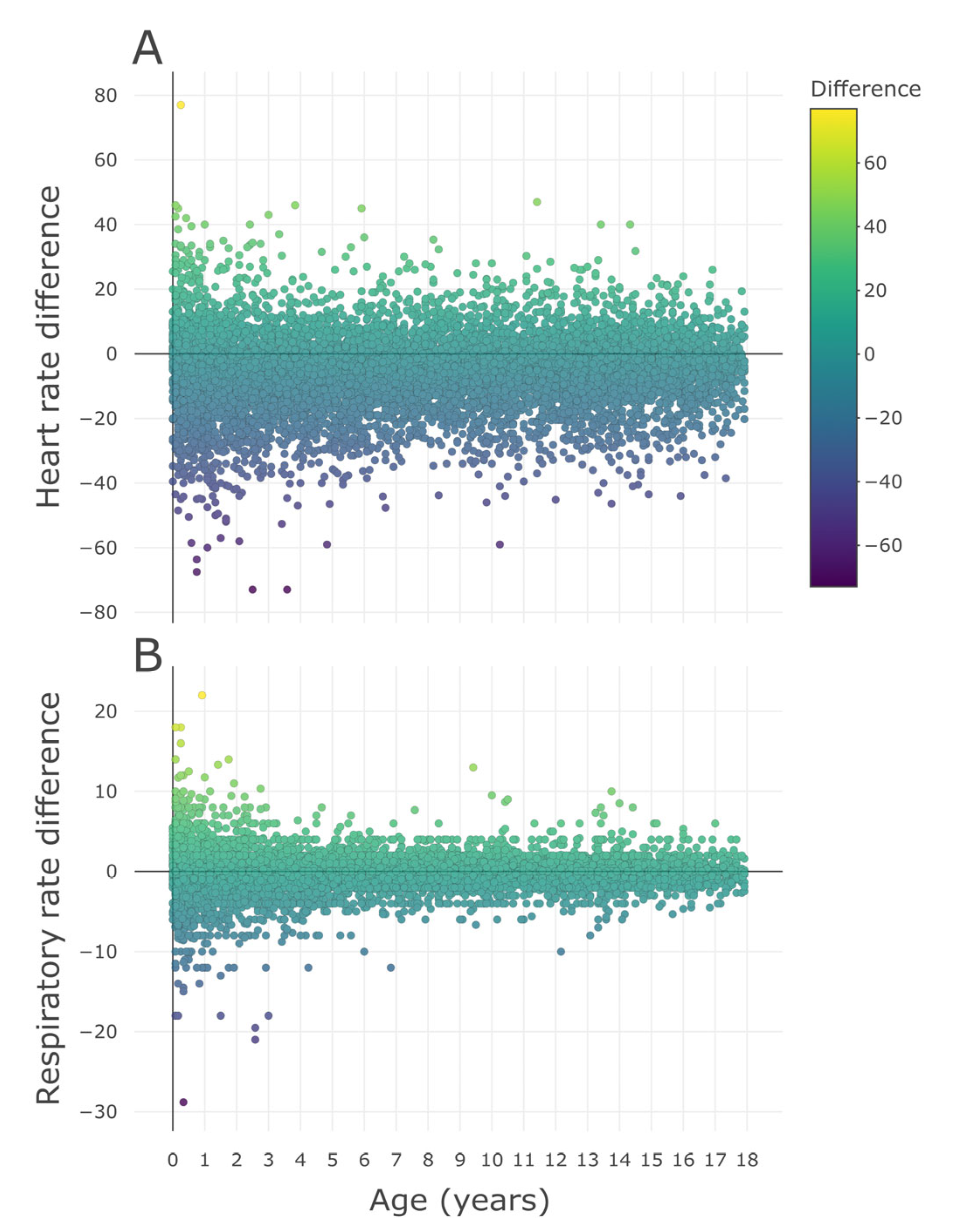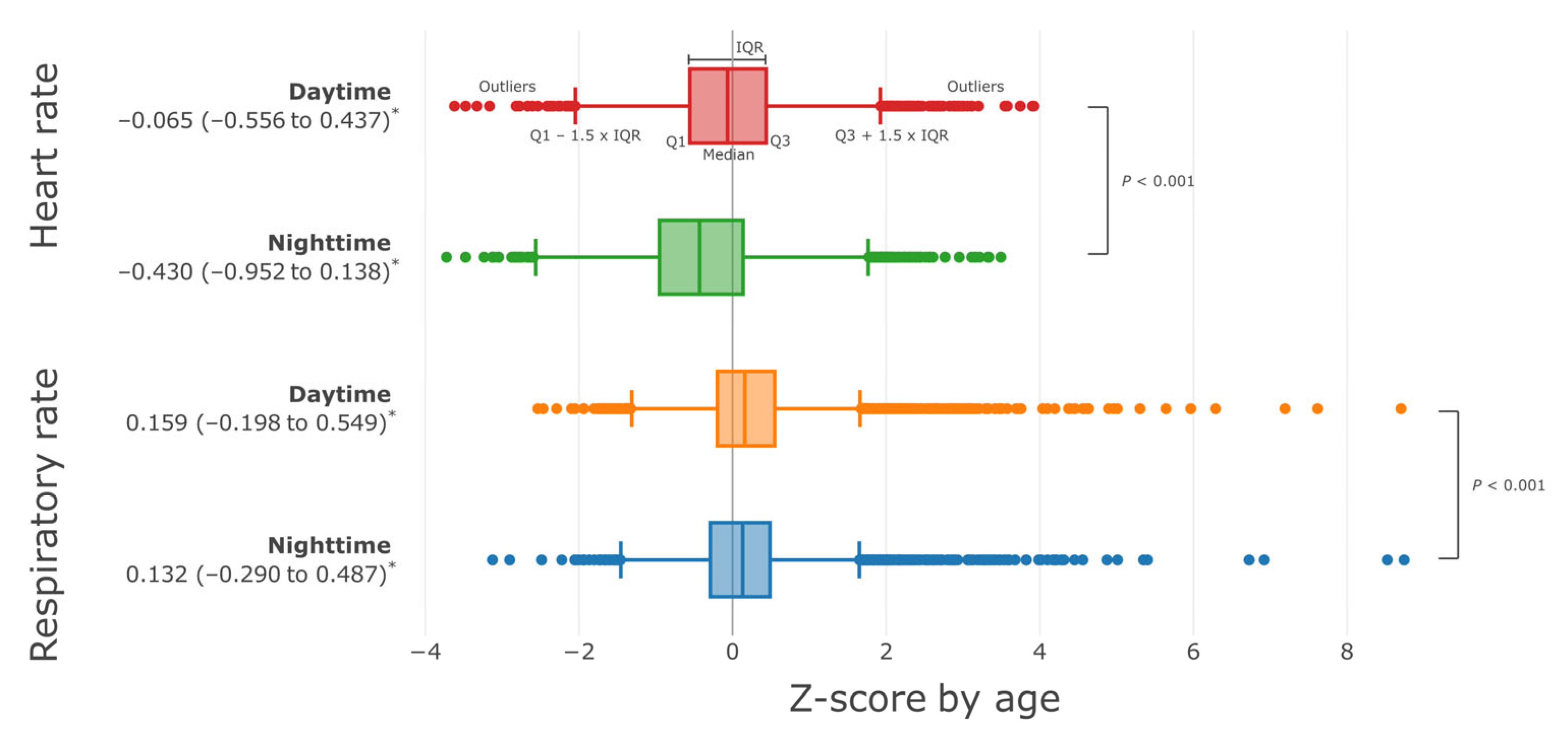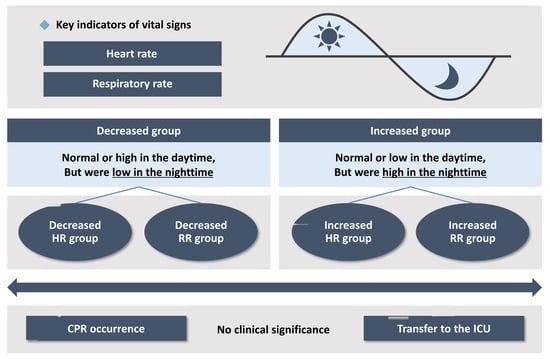Effect of Diurnal Variation of Heart Rate and Respiratory Rate on Activation of Rapid Response System and Clinical Outcome in Hospitalized Children
Abstract
:1. Introduction
2. Materials and Methods
2.1. Study Setting and Design
2.2. RRS Activation Criteria and Classification of Abnormalities in Measurements
2.3. Outcomes
2.4. Statistical Analyses
3. Results
3.1. Clinical Characteristics of the Patients
3.2. Main Outcomes

4. Discussion
5. Conclusions
Supplementary Materials
Author Contributions
Funding
Institutional Review Board Statement
Informed Consent Statement
Data Availability Statement
Conflicts of Interest
References
- Topjian, A.A.; Raymond, T.T.; Atkins, D.; Chan, M.; Duff, J.P.; Joyner, B.L., Jr.; Lasa, J.J.; Lavonas, E.J.; Levy, A.; Mahgoub, M.; et al. Part 4: Pediatric Basic and Advanced Life Support: 2020 American Heart Association Guidelines for Cardiopulmonary Resuscitation and Emergency Cardiovascular Care. Circulation 2020, 142, S469–S523. [Google Scholar] [CrossRef] [PubMed]
- Van de Voorde, P.; Turner, N.M.; Djakow, J.; de Lucas, N.; Martinez-Mejias, A.; Biarent, D.; Bingham, R.; Brissaud, O.; Hoffmann, F.; Johannesdottir, G.B.; et al. European Resuscitation Council Guidelines 2021: Paediatric Life Support. Resuscitation 2021, 161, 327–387. [Google Scholar] [CrossRef]
- Duncan, H.; Hutchison, J.; Parshuram, C.S. The Pediatric Early Warning System score: A severity of illness score to predict urgent medical need in hospitalized children. J. Crit. Care 2006, 21, 271–278. [Google Scholar] [CrossRef]
- Parshuram, C.S.; Dryden-Palmer, K.; Farrell, C.; Gottesman, R.; Gray, M.; Hutchison, J.S.; Helfaer, M.; Hunt, E.A.; Joffe, A.R.; Lacroix, J.; et al. Effect of a Pediatric Early Warning System on All-Cause Mortality in Hospitalized Pediatric Patients: The EPOCH Randomized Clinical Trial. JAMA 2018, 319, 1002–1012. [Google Scholar] [CrossRef]
- Parshuram, C.S.; Hutchison, J.; Middaugh, K. Development and initial validation of the Bedside Paediatric Early Warning System score. Crit. Care 2009, 13, R135. [Google Scholar] [CrossRef]
- Tibballs, J.; Kinney, S.; Duke, T.; Oakley, E.; Hennessy, M. Reduction of paediatric in-patient cardiac arrest and death with a medical emergency team: Preliminary results. Arch. Dis. Child. 2005, 90, 1148–1152. [Google Scholar] [CrossRef] [PubMed]
- Tibballs, J.; Kinney, S. Reduction of hospital mortality and of preventable cardiac arrest and death on introduction of a pediatric medical emergency team. Pediatr. Crit. Care Med. A J. Soc. Crit. Care Med. World Fed. Pediatr. Intensive Crit. Care Soc. 2009, 10, 306–312. [Google Scholar] [CrossRef] [PubMed]
- Nakagawa, M.; Iwao, T.; Ishida, S.; Yonemochi, H.; Fujino, T.; Saikawa, T.; Ito, M. Circadian rhythm of the signal averaged electrocardiogram and its relation to heart rate variability in healthy subjects. Heart 1998, 79, 493–496. [Google Scholar] [CrossRef]
- Southall, D.P.; Johnston, F.; Shinebourne, E.A.; Johnston, P.G.B. 24-Hour Electrocardiographic Study of Heart-Rate and Rhythm Patterns in Population of Healthy-Children. Brit. Heart J. 1981, 45, 281–291. [Google Scholar] [CrossRef]
- Rusconi, F.; Castagneto, M.; Gagliardi, L.; Leo, G.; Pellegatta, A.; Porta, N.; Razon, S.; Braga, M. Reference Values for Respiratory Rate in the First 3 Years of Life. Pediatrics 1994, 94, 350–355. [Google Scholar] [CrossRef]
- Mason, K.P.; Lönnqvist, P.A. Bradycardia in perspective—Not all reductions in heart rate need immediate intervention. Pediatr. Anesth. 2015, 25, 44–51. [Google Scholar] [CrossRef] [PubMed]
- Choi, Y.H.; Lee, H.S.; Lee, B.J.; Suh, D.I.; Park, J.D. Effectiveness of Bradycardia as a Single Parameter in the Pediatric Acute Response System. Korean J. Crit. Care Med. 2014, 29, 297–303. [Google Scholar] [CrossRef]
- Davies, P.; Maconochie, I. The relationship between body temperature, heart rate and respiratory rate in children. Emerg. Med. J. 2009, 26, 641–643. [Google Scholar] [CrossRef]
- Poole, A.E.; Macko, D.J. Pediatric vital signs: Recording methods and interpretations. Pediatr. Dent. 1984, 6, 10–16. [Google Scholar] [PubMed]
- Haines, C.; Perrott, M.; Weir, P. Promoting care for acutely ill children—Development and evaluation of a paediatric early warning tool. Intensive Crit. Care Nurs. 2006, 22, 73–81. [Google Scholar] [CrossRef]
- Tume, L. The deterioration of children in ward areas in a specialist children’s hospital. Nurs. Crit. Care 2007, 12, 12–19. [Google Scholar] [CrossRef]
- Rigby, R.A.; Stasinopoulos, D.M. Automatic smoothing parameter selection in GAMLSS with an application to centile estimation. Sociol. Methods Res. 2014, 23, 318–332. [Google Scholar] [CrossRef] [PubMed]
- Cole, T.J.; Donaldson, M.D.; Ben-Shlomo, Y. SITAR—A useful instrument for growth curve analysis. Int. J. Epidemiol. 2010, 39, 1558–1566. [Google Scholar] [CrossRef] [PubMed]
- Bae, W.; Kim, K.; Lee, B. Distribution of Pediatric Vital Signs in the Emergency Department: A Nationwide Study. Children 2020, 7, 89. [Google Scholar] [CrossRef]
- Van Kuiken, D.; Huth, M.M. What is' normal?'Evaluating vital signs. Pediatr. Nurs. 2013, 39, 216. [Google Scholar]
- Fleming, S.; Thompson, M.; Stevens, R.; Heneghan, C.; Pluddemann, A.; Maconochie, I.; Tarassenko, L.; Mant, D. Normal ranges of heart rate and respiratory rate in children from birth to 18 years of age: A systematic review of observational studies. Lancet 2011, 377, 1011–1018. [Google Scholar] [CrossRef] [PubMed]
- Bonafide, C.P.; Brady, P.W.; Keren, R.; Conway, P.H.; Marsolo, K.; Daymont, C. Development of heart and respiratory rate percentile curves for hospitalized children. Pediatrics 2013, 131, e1150–e1157. [Google Scholar] [CrossRef] [PubMed]
- Sepanski, R.J.; Godambe, S.A.; Zaritsky, A.L. Pediatric Vital Sign Distribution Derived From a Multi-Centered Emergency Department Database. Front. Pediatr. 2018, 6, 66. [Google Scholar] [CrossRef]
- O'Leary, F.; Hayen, A.; Lockie, F.; Peat, J. Defining normal ranges and centiles for heart and respiratory rates in infants and children: A cross-sectional study of patients attending an Australian tertiary hospital paediatric emergency department. Arch. Dis. Child. 2015, 100, 733–737. [Google Scholar] [CrossRef] [PubMed]
- Pollack, M.M.; Patel, K.M.; Ruttimann, U.E. PRISM III: An updated Pediatric Risk of Mortality score. Crit. Care Med. 1996, 24, 743–752. [Google Scholar] [CrossRef]
- Pollack, M.M.; Holubkov, R.; Funai, T.; Dean, J.M.; Berger, J.T.; Wessel, D.L.; Meert, K.; Berg, R.A.; Newth, C.J.L.; Harrison, R.E.; et al. The Pediatric Risk of Mortality Score: Update 2015. Pediatr. Crit. Care Med. 2016, 17, 2–9. [Google Scholar] [CrossRef]
- Straney, L.; Clements, A.; Parslow, R.C.; Pearson, G.; Shann, F.; Alexander, J.; Slater, A. Paediatric index of mortality 3: An updated model for predicting mortality in pediatric intensive care. Pediatr. Crit. Care Med. A J. Soc. Crit. Care Med. World Fed. Pediatr. Intensive Crit. Care Soc. 2013, 14, 673–681. [Google Scholar] [CrossRef]


| Variables | No. of Patients (%) (n = 9778) |
|---|---|
| Age (years) | 7.1 (2.7 to 12.2) |
| Female sex | 4394 (44.9) |
| Heart rate (beats/min) | |
| Daytime 1 | 104.0 (92.0 to 119.0) |
| Nighttime 2 | 98.5 (86.5 to 112.0) |
| Difference 3 | −5.1 (−11.7 to 0.5) |
| Respiratory rate (breaths/min) | |
| Daytime 1 | 23.5 (20.4 to 27.0) |
| Nighttime 2 | 23.5 (20.0 to 26.5) |
| Difference 3 | 0.0 (−1.0 to 0.5) |
| RRS activation | 1021 (10.4) |
| CPR occurrence | 69 (0.7) |
| ICU transfer | 541 (5.5) |
| Variables | OR (95% CI) | p |
|---|---|---|
| Decreased HR group | ||
| RRS activation | 4.928 (3.406–7.129) | <0.001 |
| CPR occurrence | 0.595 (0–49,800,930.118) | 0.956 |
| ICU transfer | 0.495 (0.177–1.389) | 0.182 |
| Decreased RR group | ||
| RRS activation | 2.366 × 1037 (NA) | 1.000 |
| CPR occurrence | 0 (NA) | 1.000 |
| ICU transfer | 0 (NA) | 1.000 |
| Increased HR group | ||
| RRS activation | 4.429 (1.155–16.990) | 0.030 |
| CPR occurrence | 0 (NA) | 1.000 |
| ICU transfer | 0 (NA) | 1.000 |
| Increased RR group | ||
| RRS activation | 7.608 (1.788–32.367) | 0.006 |
| CPR occurrence | 61.58 (0.013–296,863.903) | 0.341 |
| ICU transfer | 0.078 (0.001–10.379) | 0.307 |
Disclaimer/Publisher’s Note: The statements, opinions and data contained in all publications are solely those of the individual author(s) and contributor(s) and not of MDPI and/or the editor(s). MDPI and/or the editor(s) disclaim responsibility for any injury to people or property resulting from any ideas, methods, instructions or products referred to in the content. |
© 2023 by the authors. Licensee MDPI, Basel, Switzerland. This article is an open access article distributed under the terms and conditions of the Creative Commons Attribution (CC BY) license (https://creativecommons.org/licenses/by/4.0/).
Share and Cite
Kim, L.; Yun, K.S.; Park, J.D.; Lee, B. Effect of Diurnal Variation of Heart Rate and Respiratory Rate on Activation of Rapid Response System and Clinical Outcome in Hospitalized Children. Children 2023, 10, 167. https://doi.org/10.3390/children10010167
Kim L, Yun KS, Park JD, Lee B. Effect of Diurnal Variation of Heart Rate and Respiratory Rate on Activation of Rapid Response System and Clinical Outcome in Hospitalized Children. Children. 2023; 10(1):167. https://doi.org/10.3390/children10010167
Chicago/Turabian StyleKim, Lia, Kyoung Sung Yun, June Dong Park, and Bongjin Lee. 2023. "Effect of Diurnal Variation of Heart Rate and Respiratory Rate on Activation of Rapid Response System and Clinical Outcome in Hospitalized Children" Children 10, no. 1: 167. https://doi.org/10.3390/children10010167








